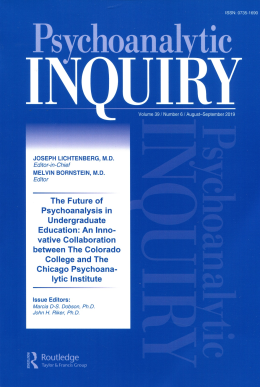
The most recent issue of the journal Psychoanalytic Inquiry is devoted entirely to examining a psychoanalysis course taught by two Colorado College professors at the Chicago Psychoanalytic Institute, looking at how psychoanalysis might best be integrated into undergraduate education, and why it is crucial to do so.
The fundamental intention of the issue, titled "The Future of Psychoanalysis in Undergraduate Education: An Innovative Collaboration between the Colorado College and the Chicago Psychoanalytic Institute," is to show how much young persons can learn from, and be transformed by, such an in-depth engagement with psychoanalysis.
The journal is dedicated to a course taught by CC Professor of Philosophy John Riker and Professor of Classics Marcia Dobson, who also has a Ph.D. in clinical psychology. The husband-and-wife team have been taking CC students to the Chicago Psychoanalytic Institute for 11 years for a month in the summer as part of their "Contemporary Psychoanalysis: Theory and Practice" class. This year, their 12th teaching the course, they are taking the students during Block 3.
Students interact with as many as 15 analysts in 17 days. During this time, Riker and Dobson assign readings and have the students read articles, discuss what the psychoanalysts have said, tie thematic threads together, direct the students to formulate questions before each class and write post-class responses.
Because Chicago is the home of psychoanalytic self-psychology, the students study Heinz Kohut, an Austrian-American psychoanalyst best known for his development of self-psychology, an influential school of thought within psychodynamic/psychoanalytic theory which helped transform the modern practice of analytic and dynamic treatment approaches. The class, which ranges between nine and 18 students, reads some of Kohut's original articles and Allen Siegel's 1996 book, "Heinz Kohut and the Psychology of the Self. " The course includes a visit to Siegel's home in a Chicago suburb for a barbeque and Saturday class in which students ask Siegel any questions they might have about self-psychology.
The capstone project for the course is an annotated bibliography or longer paper on some topic that has fascinated the students in the course or the analysis of a work of art from the Art Institute of Chicago.
The journal contains essays by Riker and Dobson, who founded CC's nationally recognized psychoanalysis minor, on why it is important to teach psychoanalysis to undergraduates, a description of the course, a section on how the students responded to each of the analysts who taught them, and six students papers, two of which went on to win the American Psychoanalytic Association's award for the best paper written by an undergraduate in a particular year.
After the Chicago class culminates, numerous students go on to complete the psychoanalysis minor, which requires a capstone paper. Additionally, a large number of students go on to receive higher degrees in mental health fields.
Included in the journal are capstone papers by Katrin Gentry '19, "Healing the Healer's Art"; Caroline Beaton '13, "To the Lighthouse and the Oedipal Triangle"; and Emily Elder '16, "Beyond the Symptoms: Generalizations and Distinctions between Eating Disorders with Different Symptom Manifestations in Psychoanalysis."
Short papers from the course included in the journal include those by Monica Black '19, "Why Perform?"; Rebecca Stine '19, "She's Waiting for Godot, and I'm Waiting with Her"; and Peter Lehman '20, "Neurobiology and Psychoanalysis."
To date, approximately 200 students have taken the "Contemporary Psychoanalysis: Theory and Practice" course, or a second course in Chicago, which was offered for several years, "Psychoanalysis, Culture, and Society."


